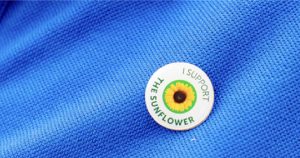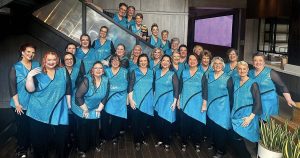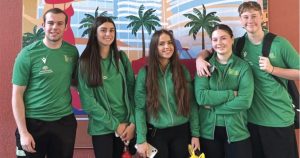Viv Kartsounis may have thousands of shoes at her Waitara home – but she’ll never wear them – and she has nowhere to put them.
Viv is the woman behind the remarkable local charity Shoes for Planet Earth. It has put sports shoes on the feet of over 51,000 disadvantaged and homeless kids and adults in 20 countries around the world from Rwanda and Papua New Guinea to right here in Sydney.
But her home looks more like a shoe shop with all the donations she receives – and she’s calling on the local community to find her a place to store the thousands of pre-loved donated runners that clog every inch of her home.
“I need free storage anywhere between Hornsby and Turramurra,” said the mother of two and engineering draughtsperson, for whom the Shoes for Planet Earth is her real passion. “Then I can have my house back.”
First steps
It was while Viv was running for Australia in the 100km World Cup competitions in a running career spanning 30 years, that she first matched sports shoes with people in need.
“The Shoes for Planet Earth idea started in 2009 after a visit to South Africa to run the Comrades Marathon, a 92km race between two cities. My partner Nick and I both completed the event and it was en route that we noticed the poverty. So many people are barefoot – I’ve seen people wearing plastic bags tied to their feet as they couldn’t afford shoes.
“Back in Australia I decided that one way I could make a difference was to send running shoes to these people.
“As a South African by birth, I have the contacts to distribute the shoes and as a runner, I have access to many pairs of shoes from running contacts and friends. Running has been so good to me, and it seemed a natural connection.
“I collected, washed and mailed the first box of 13 pairs only to realise that we couldn’t afford to send shoes internationally on a regular basis. I tried washing them in a cement mixer to save my washing machine, but that didn’t work, so now we always ask that people only send clean ones so I’m not washing thousands of shoes.”
So Viv decided to look locally – only to realise that there’s also a huge need all over Australia for trainers. Now she’s known in running circles as the ‘Shoe Fairy’, with donations flooding in from shoes stores, gyms, podiatrists and clubs, as well as company and school drives.
Stories of the differences the shoes have made are many, with the links with shoes and fitness finely interwoven.
“A contact in the Northern Territory told me it was the happiest day in the lives of the indigenous kids who received the runners we’d sent them. They’d never had shoes – now they get up early before school and put on these shoes and go for a run, so excited!
“In Africa a man will spend his whole month’s salary on a pair of shoes as it’s a status symbol. When you have no shoes people think you’re poor. People will walk nine kilometres in the freezing cold early morning to work, in thongs or shoes fashioned from old tyres. We sent a container to a church in South Africa and we heard how it changed lives, because it enabled people to get out and get jobs.”
Closer to home
Back in Sydney Viv runs a weekly walking group for the inner city homeless, turning up at a food truck weekly armed with sack loads of runners, encouraging the homeless eating there to come for a walk in the new shoes. “One guy got so involved he lost 19 kilograms.
“Then it went a step further and we trained some of these homeless guys living in shelters to enter the Santa Fun Run and the City to Surf. They won medals for taking part, but then didn’t have a wall to hang their medals on.
“A number of these people are still my friends and when I see them in the city I get the biggest, and warmest hug.”
Other recipients close to home include include Dress for Success helping women return to the workplace, and flood victims in Moree and Queensland. Dozens of The Big Issue vendors wear Viv’s runners, also using them to play soccer when not selling the magazine.
Want to help? Here’s how it works
There are 90 permanent collection points around Australia – see the website for where they are. “So you drop your used or nearly new trainers at one of these points like sports shoes shops and podiatrists, and when we have enough pairs, I call a local agency. It might be for the homeless, a women’s shelter, a drug and alcohol rehab place, an indigenous organisation, refugee group or Heart Foundation walking group – and they come and collect them.
“That way we keep it local and sustainable so the shoes aren’t clocking up air miles. Sometimes it’s like moving chess pieces on a board, matching shoes with local groups and moving them about.”
Started with a cash grant and stack of free air miles from Jetstar, today the charity – a modest affair with just two volunteer staff and advisory board of three – runs out of Viv’s home quite literally, on a shoestring.
“We get very few financial donations and to help fund the charity we built a cabin in the bush between Lithgow and Mudgee, in the Capertee Valley, the widest canyon in the world. It’s on Airbnb and the rent pays for the running the charity.”
When they’re needed internationally, a worldwide network of roving friends, and even air hostesses do their bit: “I have an air hostess who flies to the Philippines who’s a member of a sports club there. When she flies, she distributes our shoes amongst other hostesses and they all put them in their luggage and take them back.”
Viv also needs volunteers once she has the free storage, to help her sort the mountain of brightly coloured trainers of all shapes and sizes piling up in her hallway, kitchen, living room and back verandah.
“The storage needs to be close to my house in Waitara so I can meet donors or couriers there or get there soon after, so I can lock them away. Anywhere from Hornsby to Turramurra, preferably in an industrial estate with good access for delivery trucks.”
Perhaps the last word should go to another recipient, Andrew Bagnall, a teacher in the Northern Territory, who says in a heartfelt thank-you email to Viv: “I’m lucky enough to see the impact it has on children every day, and when i was walking down the street this morning, i could see children in their shoes, lifting their feet up to show me!”







